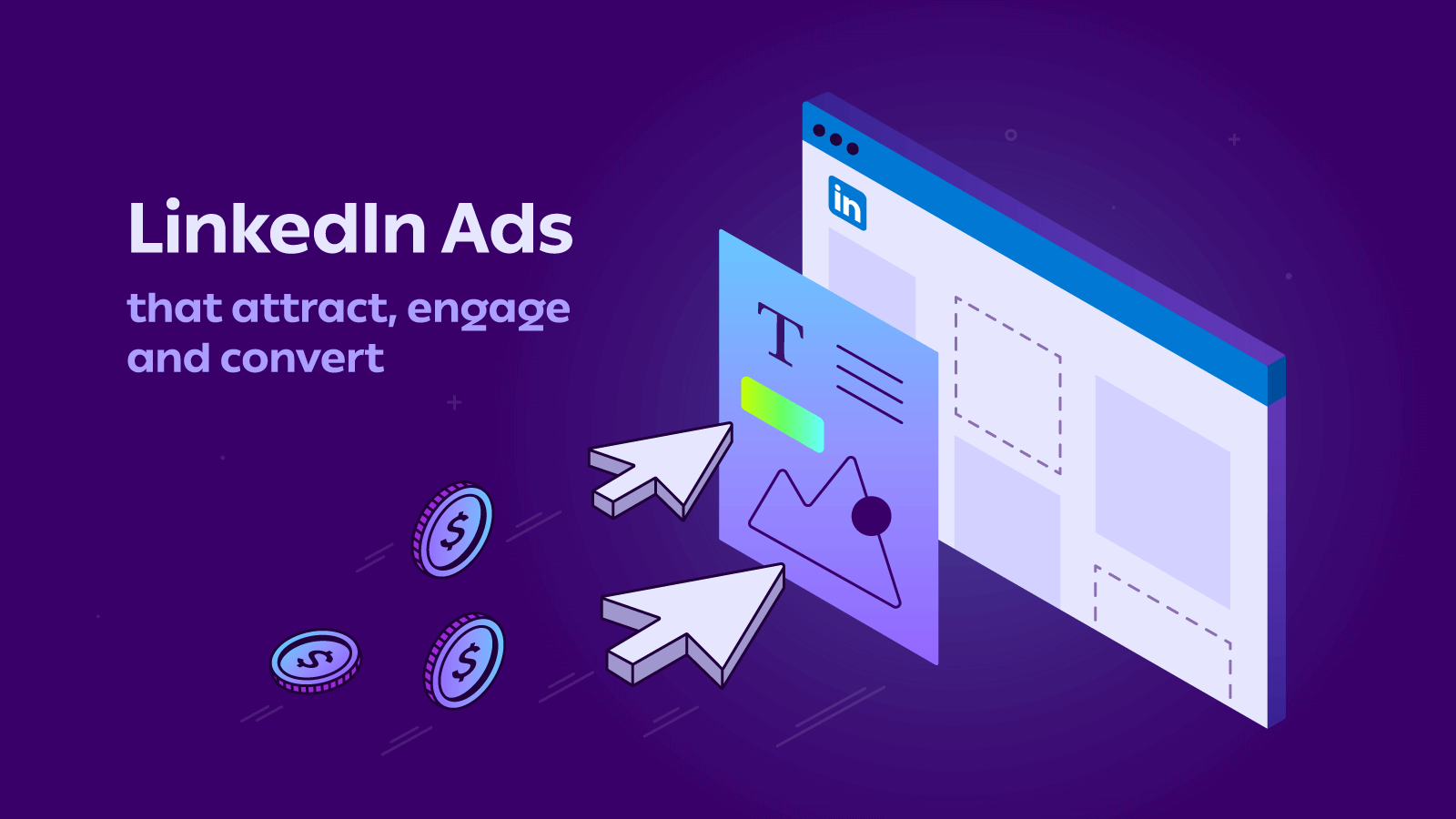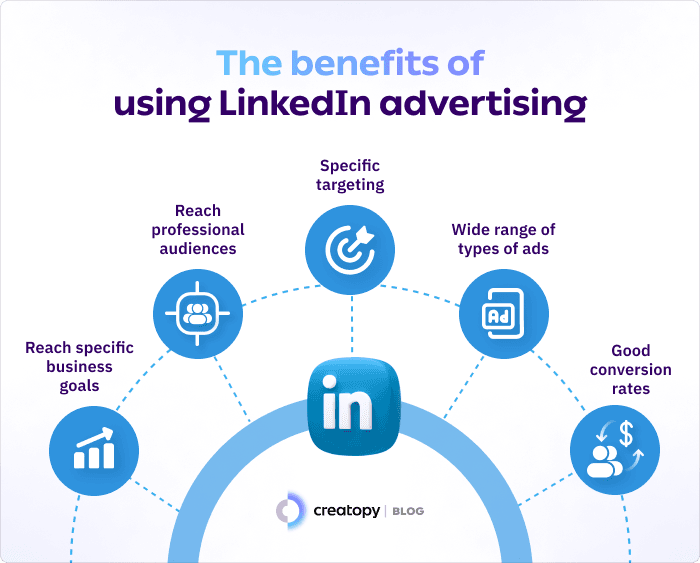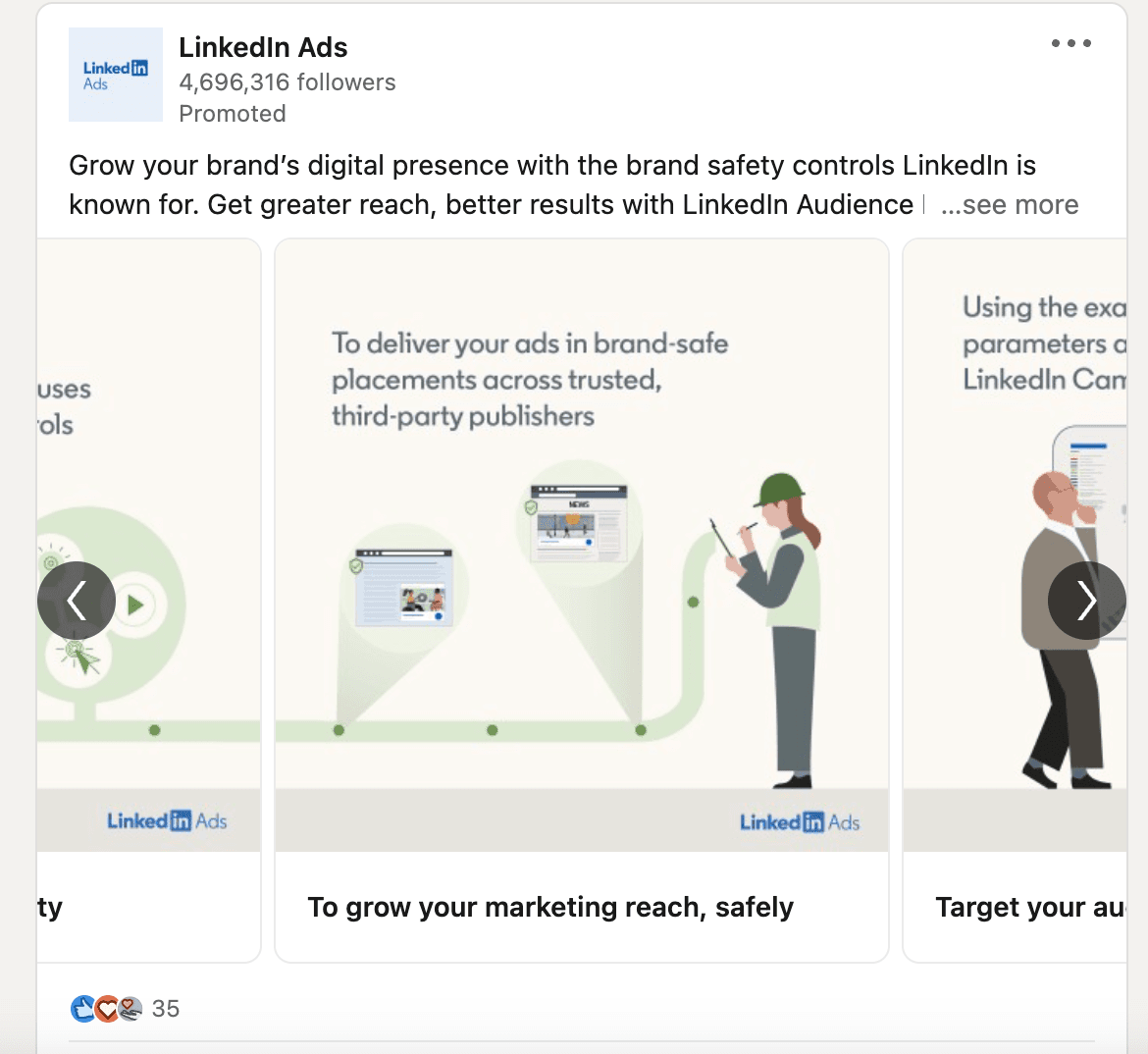The Ultimate Guide to Facebook Event Photo Sizes (2025 Update)
Diana Teslaru
Apr 15, 2025 - 9 min read
Are you an agency? Scale your team's work and impact with The Agency Package.

According to the State of Digital Advertising report released by The Brief in April 2023, LinkedIn ranked as the fourth most popular ad channel this year. And it's easy to see why the "social media for professional networking" has gained so much traction as of lately: it has a wide range of targeting options, detailed performance insights, and great potential for remarketing.
Want to know how to advertise on LinkedIn and tap into the nearly 1 billion users on LinkedIn to sell your products and services?
Here's a quick LinkedIn ads guide to teach you everything you need to know about advertising on this platform.
LinkedIn advertising is a type of advertising promoting products and services to LinkedIn users using paid ads. Most often, LinkedIn advertising is used by B2B companies to put their products in front of potential customers but some B2C companies sell with LinkedIn ads too.

According to LinkedIn, 82% of marketers realized their greatest successes on LinkedIn (as compared to other platforms). Moreover, brands have seen a 33% purchase intent after promoting their products with LinkedIn ads.
But those are just a few reasons why more and more marketers decide to use LinkedIn advertising. Here are some of the main advantages to keep in mind when deciding if this platform is for you:
LinkedIn allows you to run ads not just for the sake of running ads but to reach specific business goals, such as:
LinkedIn is the perfect "machine" if you need to reach professionals, as this is a platform built specifically for them. You can target them by job title, industry, skills, and even seniority level enabling you to reach exactly the professionals you're looking for.
LinkedIn offers more advanced targeting capabilities than other popular ad platforms. Some of the criteria by which you can target your ads include:
LinkedIn allows you to create every type of ad you'd find on other advertising platforms, including text ads, dynamic ads, sponsored content, video ads, lead gen forms, and more. Additionally, LinkedIn also offers unique types of ads, such as InMail ads, which enables users to reach audiences in their inboxes.
LinkedIn ads have a very high conversion rate, which means that the audiences you select are highly likely to convert. Depending on the type of ads you run, you can see conversion rates ranging from 1.5%-4% (for demo requests, trials, etc.) to 10%-15% (for content downloads, video views, etc.).
To know how to advertise on LinkedIn efficiently, you should first get acquainted with the main types of LinkedIn ads. As mentioned before, LinkedIn offers a wide range of types of ads, such as:
Sponsored content ads are ads that look native to the platform (as if they'd be an organic LinkedIn post). These ads are available as single image, carousel, video, and event ads, with the following specs.

Sponsored InMail ads are promotional messages sent directly to the inboxes of your target audience. The advantage of this type of ad is that it creates a direct connection with your target audience, enabling you to reach them in a more personal way.
Text ads are an advertising option on LinkedIn you can use especially when you want to test your messaging at a relatively low cost per impression, with a high ad showing frequency. This type of ad is also great for retargeting, as it can include a clear call-to-action and engage users who have already interacted with your brand.
LinkedIn Dynamic Ads are an automated ad format that shows relevant product recommendations to prospects and customers, based on their existing LinkedIn data. These ads come in multiple formats:

LinkedIn display ads are based IAB standard image ads, and they can be used with creatives to drive awareness and engagement for your business. These ads are available in two dimensions:
LinkedIn video ads are a great way to engage and build relationships with your target audience. These ads can be used at every stage of the buyer's journey, and they have to abide by the following specifications:
Conversation ads are native ads that combine sponsored messages and the power of a chatbot. When someone is targeted with such an ad, they will receive an email with links and they can interact with the automated messages according to what they want. These ads are charged on a cost-per-send basis, and they can be used for various objectives, such as brand awareness, website visits, lead generation, engagement, or website conversions.
For example, if you're a B2B design agency, you could target a SaaS company with an engaging message, followed by a "Tell me more" button and a "Visit website" one. The conversation would then flow according to pre-established parameters and what the targeted person wants to do next.
This type of ads can be run either as Sponsored Content or as a promoted message. The main idea is that your target audience will see a form, which they can fill in to get access to a specific asset (in exchange for their contact details, which you can then use in lead nurturing campaigns).

LinkedIn's targeting options are among the most advanced ones on any advertising platform, so you can create very well-targeted ads that reach an audience likely to take action (e.g., buy from you, download your whitepaper, etc.). The main LinkedIn targeting options include:
Demographics allow you to target people according to different parameters, such as age and gender.
LinkedIn also allows you to target your ads according to your audience's title and function so you can reach very specific decision-makers in businesses.
If you want to target people working in specific companies, you can use LinkedIn's company targeting option. This allows you to target your ads according to company category, company connections, company followers, company growth rate, company industry, company name, company revenue, and company size.
Sometimes you may want to only show your ads to people with a specific education. LinkedIn allows you to filter your target audience based on degrees, field of study, and even specific schools.
If you want your ads to be contextual to what your target audience likes, LinkedIn allows you to target your ads according to members' interests, traits, and even the groups they belong to.
LinkedIn also allows you to filter your targeting according to location (and this is actually one of the few required targeting options).
The Matched Audiences option allows you to create custom audience segments based on contact lists you may have, retargeting people who interacted with your brand before (they visited your site, watched your videos, engaged with one of your ads, opened and/ or submitted a lead gen form, engaged with your company page, or RSVP’d to one of your events on LinkedIn). The platform also allows you to integrate your ads account to third-party data sources.
Lookalike Audiences are audiences similar to a matched audience segment. For instance, if you found a certain ad targeting setting works, the "lookalike" feature will enable you to replicate your success and target people with very similar characteristics.
Convinced LinkedIn is worth trying? Here's how to create an ad campaign on LinkedIn.
To run ads on LinkedIn, you should first create a Page and associate your personal account with it. LinkedIn allows you to run ads from your personal account too, but the options are limited. More specifically, you need a LinkedIn Page to run Sponsored Content ad formats (single image, video, or carousel), Dynamic Ads (follower ads, spotlight ads, and job ads), or lead gen forms.
Once you have a LinkedIn page, create a Campaign Manager account (if you haven't already) and log in. This is where you will set up your campaigns, target your audience, and set up the ad budget.
Before diving into the actual ad setting, make sure you're clear on what your campaign objectives are. They could be any of the following, for example:
Your goals and your ad format can be quite tightly connected, as some ad formats are better for some goals.
For instance, the Sponsored Content or the Sponsored Message lead gen form is a great option if you're looking to capture leads. Likewise, if you have multiple products or services to show off, or if you want to create a highly-engaging ad, carousel ads might be a great option for you.
Defining your target audience is probably the most important step in setting up your LinkedIn ad campaign. This is when you decide who to show your ads to based on criteria like job title, seniority, location, industry, company size, degrees, and more.
LinkedIn allows you to put a cap on your budget and choose your own schedule (i.e., how frequent/when you want your ads to be shown). Furthermore, LinkedIn ads also have different bidding options, such as:
Create your ad assets (copy, design, etc.) according to the specifications for each type of ad. Make sure to focus on creating engaging content, as this will be the key factor to drive engagement and, possibly, conversions.
At this step, you have to provide your payment information (such as your credit card details), so LinkedIn can charge you for the ads.
Once all the steps are done, you can launch your campaign and monitor its performance. When it's time to optimize (or even pause/ stop) your campaign, you can do that from within the
Regularly monitoring your campaign allows you to stop and adjust them according to your findings. For instance, you may find that people are not engaging with a specific text, so you might want to try a different approach to your messaging. This allows you to save money that would've otherwise been spent on inefficient advertising and redirect it towards something that works better for your target audience and business.
LinkedIn ads have a bad rep when it comes to the financial side of running ads on the platform, as most people believe this is one of the more expensive social media advertising options. They are not completely wrong, but it's all a matter of perspective.
On average, LinkedIn advertising costs revolve $5.26 per click, $6.59 per thousand impressions, and $0.80 per sponsored message sent. These are, of course, averages, and different industries, target audiences, bids, and campaigns may cost more or less than that. Also, keep in mind that your "Ad Relevance Score" (a score LinkedIn assigns to measure how relevant your ad is likely to be for your chosen audience) will also have a say in how much your campaigns cost.
While these numbers may seem high (especially as compared with other platforms (like Facebook, where one click will cost you, on average $0.94), it's all relative to how you look at it. Some platforms may have a lower CPC, but they have a high cost per impressions (Facebook ads cost more than $12 per thousand impressions, for example). And some platforms have a much lower engagement and conversion rate where, as mentioned before, LinkedIn tends to excel due to the highly targeted types of ads it allows you to run on the platform.

If you're keen on running ads on LinkedIn and want to make sure your campaigns are successful, here are some LinkedIn ads best practices to keep in mind:
While not all LinkedIn ads are visual-driven, those that are give you a chance to stand out from the crowd and stop your audience's scroll. Using a linkedin ad maker to create eye-catching designs allows you to get your audience's attention, so you can deliver them your message, even when they're not specifically looking for it. Some tips for attractive LinkedIn ad creatives include:
Your ad copy should be concise, compelling, and focused on the value you're offering. Focus on the benefits users may have if they take a specific action, rather than "business language" or "features."
Also, choose your words wisely. Here's a list of 150 of power words that tend to drive engagement and action.
When creating ads, remember your audience. Sometimes may not seem appealing to you, but it may be 100% appropriate for your audience, so always filter your ideas through the lens of your target and their interests.
A/B testing allows you to find out which ads work best for your target audience, as well as what kind of messages, visuals and calls-to-action drive the most conversions. Keep in mind you should only test one variable at a time, while keeping everything else constant (for example, you can test different visuals but with the same copy).
Remember your users need to know what the next step is and a CTA does just that. It serves no one to have the best and most engaging copy in the world if the CTA is unclear. Make sure you always use actionable words in your CTA and make it as clear and straightforward as possible.
It is very likely you won't get the results you want on your first campaign and that's totally ok. The more you experiment, the better understanding you'll have of your audience's needs and reactions. Use different bid options (including automatic bids) to find out which ones work best for you, and optimize your budget to get the most out of your campaigns.
Following LinkedIn's advertising policies is essential if you want your ads to be actually published and seen by your target. You can read more about the specific advertising policies on Linkedin here.
Once your ads are live on the platform, you need to keep an eye on them. Continuously monitor and optimize your campaigns so you can get the best results from your efforts. Track clicks, conversions, and engagement rates to make sure your campaigns are on track (or adjust them as needed).
Conversion tracking allows you to monitor how your ads are performing in terms of leads, sales, and other key actions. With it, you can effectively measure the return on investment (ROI) of your campaigns, so you can focus on ads that are actually driving results for your business.
Although LinkedIn ads are frequently believed to be more expensive than other types of ads, they might also be the best option for you if you're looking for a high-quality audience with purchasing power and decision making authority—particularly if you sell B2B products and services. With its advanced targeting, large pool of professionals, and well-structured ad formats, LinkedIn ads can be an effective way to reach business decision makers on the world's largest professional network.
In fact, LinkedIn ads make such an attractive proposition for many that it ranked first on the top of the platforms advertisers want to try in 2023 (24.5% of our respondents in The State of Digital Advertising survey said they want to give LinkedIn a test run this year).
If you're among them and if you've decided to finally test LinkedIn ads, here are the key points to remember from this article:
LinkedIn ads may not be for everyone, sure. But before you give it a final "no," keep in mind that one LinkedIn ad can reach more than 14% of the global population. What's more, half of the brands that advertise on LinkedIn are seen as "higher-quality," which means running ads on LinkedIn can position your company as a desirable supplier of goods and services.
Ready to run ads on LinkedIn? Consider The Brief for your ad creatives if you want to produce beautiful, engaging ad designs at scale.
7 days free on us
Let's put these insights into action. Build, scale, and automate campaigns with AI-powered workflows.
Diana Teslaru
Apr 15, 2025 - 9 min read
Claudia
Mar 27, 2025 - 22 min read
Derya Yildirim
Mar 10, 2025 - 9 min read